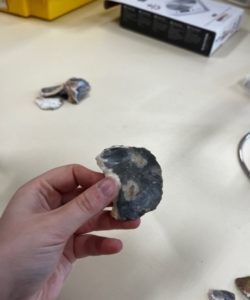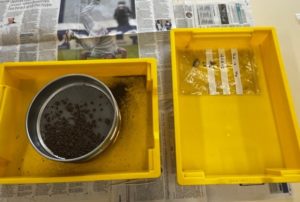I’m Jodie-Leigh Bowater, a BA Social Anthropology and Archaeology student who worked on Paul Garwood’s “Stonehenge Landscape EMI Project: Artefacts Processing, Analysis, and Archiving Programme.”
Firstly, let’s begin with a background of my internship; my role this summer has been to work on the material recovered from the Stonehenge Landscape EMI project (SLE), specifically artefacts and materials from the years 2017 and 2018. This work included the (mildly therapeutic) acts of washing, re-bagging, counting and weighing artefacts ranging from the most delicate of pottery, to bone and antler and the most gargantuan bags of flint I have ever seen. You may be asking: what is the point of all of this? Well, let me explain…
Stonehenge is much more than a site of just “big rocks”, in fact, the surrounding areas of Stonehenge contain a variety of archaeological wonders. Even seemingly mundane objects like flint have offered me a glance into prehistory through the use of lithics analysis. The point of my role as an intern was to aid in digitalising the abundance of material which had not yet been recorded from the SLE project; this was mainly from the 2018 season, with the odd bits and pieces from 2017. This part of the internship can only be described as relaxed, educational, and a little bit messy (chalk-covered antlers – I’m looking at you).

The steady rhythm of washing, re-bagging, counting, weighing, gave me a lot of space to ponder on the materials I was handling. After the initial oh my god, it’s from Stonehenge excitement (who knew I could get so excited about flint?!), I was able to think more deeply and thoughtfully about the artefacts. Many of those aforementioned large bags of flint were evidence of someone’s hard work: hours upon hours of knapping, the act of forcefully removing flakes of flint from its original form. Imagine hitting a rock repeatedly for hours on end just to take smaller flakes and make yourself a scraper, or an axe, or some nice new arrowheads? Well, this was reality for those living in the Neolithic period of prehistory, and is something that can give us insight into our prehistoric past.

The second half of my internship was predominantly independent research into pits excavated at Stonehenge. I worked specifically on the pits of Stonehenge car park (Cleal et al. 1995), Coneybury Henge, King Barrow Ridge and the ‘Coneybury Anomaly’ (Richards 1990). This research taught me a lot about the research and effort that goes into written archaeological work. Pit records (which I was creating) act as a summarised source of information for archaeologists, where they can look at the significant information easily instead of having to sift and search through books. This aspect of my internship has taught me more about focused research, and I have undoubtedly gained more skills in scouring texts for information and singling out what I need for the task at hand. During this period, I also spent one final day in the Material Culture Lab on campus to do some last minute re-bagging and moving of materials, and a spot of dry-sieving.
To finish off, I would like to say thank you to Paul for giving myself and my intern partner the opportunity to be part of the SLE project and for the experiences we have gained along the way. This internship has allowed me to develop more archaeological skills as well as furthering my passion for archaeology itself. It has also shown me how important dedication, perseverance and adaptability is when completing such work. I have gained an appreciation for the work archaeologists do beyond excavating and fieldwork. Being able to handle items such as delicate pottery and flint tools was for me a wonderful experience and one that I am glad I committed to this summer; I hope I have the opportunity in the future to complete a similar role as this experience has been fun, educational and rewarding.
